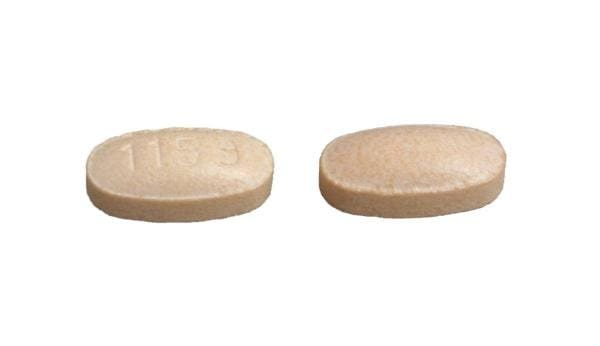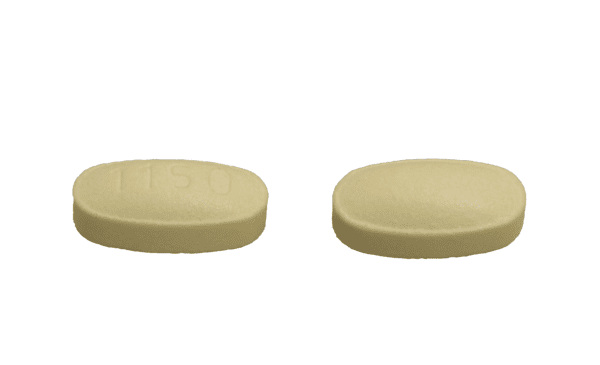Dosage Forms
Excipient information presented when available (limited, particularly for generics); consult specific product labeling.
Tablet Extended Release 24 Hour, Oral:
Myrbetriq: 25 mg, 50 mg
Pharmacology
Mechanism of Action
Mirabegron, a beta-3 adrenergic receptor agonist, activates beta-3 adrenergic receptors in the bladder resulting in relaxation of the detrusor smooth muscle during the urine storage phase, thus increasing bladder capacity. At usual doses, mirabegron is believed to display selectivity for the beta-3 adrenergic receptor subtype compared to its affinity for the beta-1 and -2 adrenoceptor subtypes. Data have shown that beta-adrenoceptors, predominately the beta-3 subtype, mediate detrusor smooth muscle tone and promote the storage function of the human bladder.
Pharmacokinetics/Pharmacodynamics
Distribution
Vss: ~1670 L (following IV administration)
Metabolism
Extensive metabolism via multiple pathways (eg, dealkylation, oxidation, glucuronidation, amide hydrolysis) via multiple enzymes (eg, UGT, esterase, CYP3A4, CYP2D6); two major pharmacologically inactive metabolites produced
Excretion
Urine (radiolabeled drug: 55%; unchanged drug: ~25%); feces (radiolabeled drug: 34%; unchanged drug: 0%)
Onset of Action
Efficacy is seen within 8 weeks; steady state achieved within 7 days
Time to Peak
~3.5 hours
Half-Life Elimination
~50 hours
Protein Binding
~71%; binds mainly to albumin and alpha1-acid glycoprotein
Use in Specific Populations
Special Populations: Renal Function Impairment
Following single dose administration of mirabegron 100 mg in volunteers with mild renal impairment (estimated glomerular filtration rate [eGFR] 60 to 89 mL/minute/1.73 m2 as estimated by modification of diet in renal disease), mean mirabegron Cmax and AUC were increased by 6% and 31% relative to volunteers with normal renal function. In volunteers with moderate renal impairment (eGFR 30 to 59 mL/minute/1.73 m2), Cmax and AUC were increased by 23% and 66%, respectively. In patients with severe renal impairment (eGFR 15 to 29 mL/minute/1.73 m2), mean Cmax and AUC values were 92% and 118% higher compared with healthy subjects with normal renal function.
Special Populations: Hepatic Function Impairment
Following single-dose administration of mirabegron 100 mg in volunteers with mild hepatic impairment (Child-Pugh class A), mean mirabegron Cmax and AUC were increased by 9% and 19% relative to volunteers with normal hepatic function. In volunteers with moderate hepatic impairment (Child-Pugh class B), mean Cmax and AUC values were 175% and 65% higher.
Special Populations: Gender
The Cmax and AUC of mirabegron were approximately 40% to 50% higher in females than in males. When corrected for differences in body weight, the mirabegron systemic exposure is 20% to 30% higher in females compared with males.
Use: Labeled Indications
Overactive bladder: Treatment of overactive bladder (OAB) with symptoms of urinary frequency, urgency, or urge urinary incontinence as monotherapy or in combination with solifenacin
Contraindications
Hypersensitivity to mirabegron or any component of the formulation
Canadian labeling: Additional contraindications (not in US labeling): Severe uncontrolled hypertension (systolic blood pressure ≥180 mm Hg and/or diastolic blood pressure ≥110 mm Hg); pregnancy
Dosage and Administration
Dosing: Adult
Overactive bladder (OAB): Oral: Initial: 25 mg once daily; efficacy is observed within 8 weeks for 25 mg dose. May increase to 50 mg once daily based on individual patient efficacy and tolerability.
Concomitant use with solifenacin: Initial: 25 mg once daily with solifenacin 5 mg once daily. May increase mirabegron dose to 50 mg once daily after 4 to 8 weeks.
Dosing: Geriatric
Refer to adult dosing.
Administration
Administer without regard to food. Swallow the tablet whole with water; do not chew, divide, or crush.
Storage
Store at 25°C (77°F); excursions permitted to 15°C to 30°C (59°F to 86°F).
Mirabegron Images
Drug Interactions
Ajmaline: CYP2D6 Inhibitors (Moderate) may increase the serum concentration of Ajmaline. Monitor therapy
Amphetamines: CYP2D6 Inhibitors (Moderate) may increase the serum concentration of Amphetamines. Monitor therapy
Anticholinergic Agents: May enhance the adverse/toxic effect of Mirabegron. Monitor therapy
ARIPiprazole: CYP2D6 Inhibitors (Moderate) may increase the serum concentration of ARIPiprazole. Management: Monitor for increased aripiprazole pharmacologic effects. Aripiprazole dose adjustments may or may not be required based on concomitant therapy and/or indication. Consult full interaction monograph for specific recommendations. Monitor therapy
Brexpiprazole: CYP2D6 Inhibitors (Moderate) may increase the serum concentration of Brexpiprazole. Management: If brexpiprazole is to be used together with both a moderate CYP2D6 inhibitor and a strong or moderate CYP3A4 inhibitor, the brexpiprazole dose should be reduced to 25% of the usual dose. Monitor therapy
CloZAPine: CYP2D6 Inhibitors (Moderate) may increase the serum concentration of CloZAPine. Monitor therapy
Codeine: CYP2D6 Inhibitors (Moderate) may diminish the therapeutic effect of Codeine. These CYP2D6 inhibitors may prevent the metabolic conversion of codeine to its active metabolite morphine. Monitor therapy
CYP2D6 Substrates (High risk with Inhibitors): CYP2D6 Inhibitors (Moderate) may decrease the metabolism of CYP2D6 Substrates (High risk with Inhibitors). Exceptions: Tamoxifen. Monitor therapy
Desipramine: Mirabegron may increase the serum concentration of Desipramine. Monitor therapy
Digoxin: Mirabegron may increase the serum concentration of Digoxin. Management: Consider using the lowest dose of digoxin when initiating concurrent mirabegron. Monitor serum digoxin concentrations closely to help guide digoxin dosing. Consider therapy modification
DOXOrubicin (Conventional): CYP2D6 Inhibitors (Moderate) may increase the serum concentration of DOXOrubicin (Conventional). Management: Seek alternatives to moderate CYP2D6 inhibitors in patients treated with doxorubicin whenever possible. One U.S. manufacturer (Pfizer Inc.) recommends that these combinations be avoided. Consider therapy modification
Eliglustat: CYP2D6 Inhibitors (Moderate) may increase the serum concentration of Eliglustat. Management: Reduce the eliglustat dose to 84 mg daily. Avoid use of eliglustat in combination with a moderate CYP2D6 inhibitor and a strong or moderate CYP3A4 inhibitor. Consider therapy modification
Fesoterodine: CYP2D6 Inhibitors may increase serum concentrations of the active metabolite(s) of Fesoterodine. Monitor therapy
Flecainide: Mirabegron may increase the serum concentration of Flecainide. Management: Monitor clinical response to flecainide closely. Dose adjustment may be necessary. Canadian mirabegron labeling recommends restricting the maximum adult mirabegron dose to 25 mg/day in patients receiving flecainide. Monitor therapy
Indoramin: CYP2D6 Inhibitors (Moderate) may increase the serum concentration of Indoramin. Monitor therapy
Ketoconazole (Systemic): May increase the serum concentration of Mirabegron. Monitor therapy
Metoprolol: Mirabegron may diminish the antihypertensive effect of Metoprolol. Mirabegron may increase the serum concentration of Metoprolol. Monitor therapy
Nebivolol: CYP2D6 Inhibitors (Moderate) may increase the serum concentration of Nebivolol. Monitor therapy
Perhexiline: CYP2D6 Inhibitors may increase the serum concentration of Perhexiline. Management: Consider alternatives to this combination if possible. If combined, monitor for increased perhexiline serum concentrations and toxicities (eg, hypoglycemia, neuropathy, liver dysfunction). Perhexiline dose reductions will likely be required. Consider therapy modification
Pitolisant: CYP2D6 Inhibitors (Moderate) may increase the serum concentration of Pitolisant. Monitor therapy
Propafenone: Mirabegron may increase the serum concentration of Propafenone. Management: Monitor clinical response to propafenone closely. Dose adjustment may be necessary. Canadian mirabegron labeling recommends restricting the maximum adult mirabegron dose to 25 mg/day in patients receiving propafenone. Monitor therapy
RifAMPin: May decrease the serum concentration of Mirabegron. Monitor therapy
Solifenacin: Mirabegron may enhance the adverse/toxic effect of Solifenacin. Specifically, the risk of acute urinary retention may be enhanced. Monitor therapy
Tamoxifen: CYP2D6 Inhibitors (Moderate) may decrease serum concentrations of the active metabolite(s) of Tamoxifen. Specifically, CYP2D6 inhibitors may decrease the metabolic formation of highly potent active metabolites. Management: Consider alternatives with less of an inhibitory effect on CYP2D6 activity when possible. Consider therapy modification
Tamsulosin: CYP2D6 Inhibitors (Moderate) may increase the serum concentration of Tamsulosin. Monitor therapy
Thioridazine: CYP2D6 Inhibitors may increase the serum concentration of Thioridazine. Avoid combination
TraMADol: CYP2D6 Inhibitors (Moderate) may diminish the therapeutic effect of TraMADol. These CYP2D6 inhibitors may prevent the metabolic conversion of tramadol to its active metabolite that accounts for much of its opioid-like effects. Monitor therapy
Adverse Reactions
>10%: Cardiovascular: Hypertension (9% to 11%)
1% to 10%:
Cardiovascular: Tachycardia (2%)
Central nervous system: Headache (2% to 4%), dizziness (1% to 3%)
Gastrointestinal: Constipation (1% to 3%), xerostomia (4%), diarrhea (2%), abdominal pain (1%)
Genitourinary: Urinary tract infection (3% to 6%), cystitis (2%)
Infection: Influenza (3%)
Neuromuscular & skeletal: Back pain (3%), arthralgia (2%)
Respiratory: Nasopharyngitis (4%), sinusitis (3%)
<1%, postmarketing, and/or case reports: Abdominal distension, angioedema, anxiety, atrial fibrillation, bladder pain, blurred vision, breast cancer, cerebrovascular accident, confusion, dry eye syndrome, dyspepsia, gastritis, elevated gamma-glutamyl transferase, genital pruritus, glaucoma, hallucination, hypersensitivity angiitis, increased lactate dehydrogenase, increased serum alanine aminotransferase, increased serum aspartate aminotransferase, insomnia, lip edema, malignant neoplasm of lung, malignant neoplasm of prostate, nausea, nephrolithiasis, nonthrombocytopenic purpura, osteoarthritis, palpitations, pruritus, rhinitis, skin rash, urinary retention, urticaria, vaginal infection
Warnings/Precautions
Concerns related to adverse effects:
- Angioedema: Angioedema of the face, lips, tongue, and/or larynx has been reported; some cases have occurred after the first dose. May be life-threatening. Immediately discontinue and institute supportive care if the tongue, hypopharynx, or larynx is involved.
- Blood pressure effects: Dose-related increases in blood pressure have been reported; monitor blood pressure periodically during therapy. Not recommended in patients with severe uncontrolled hypertension (SBP ≥180 and/or DBP ≥110 mm Hg); if used in patients with controlled and less severe hypertension, use with caution and monitor blood pressure closely; exacerbation of preexisting hypertension has been infrequently reported.
Disease-related concerns:
- Bladder flow obstruction: Use with caution in patients with bladder outlet obstruction (BOO) and in patients using concomitant muscarinic antagonists; the risk of urinary retention may be increased.
- Hepatic impairment: Use with caution in patients with mild to moderate hepatic impairment; dosage adjustment is required in patients with moderate hepatic impairment. Use is not recommended in severe hepatic impairment.
- QT prolongation: Use with caution in patients with a history of QT interval prolongation or those receiving medications known to prolong the QT interval. In one thorough QT study, supratherapeutic doses prolonged the QTc interval based on the individual subject-specific correction method (QTcI) in females but not in males (Malik 2012). In general, mirabegron at the recommended dose has a low risk of QT interval prolongation (Sanford 2013).
- Renal impairment: Use with caution in patients with renal impairment; dosage adjustment is required in patients with severe renal impairment. Use is not recommended in ESRD.
Concurrent drug therapy issues:
- Drug-drug interactions: Potentially significant interactions may exist, requiring dose or frequency adjustment, additional monitoring, and/or selection of alternative therapy. Consult drug interactions database for more detailed information.
Monitoring Parameters
Monitor blood pressure at baseline and then periodically during therapy; signs and symptoms of urinary retention
Pregnancy
Pregnancy Considerations
Adverse effects have been observed in some animal reproduction studies.
Patient Education
What is this drug used for?
- It is used to treat an overactive bladder.
Frequently reported side effects of this drug
- Dry mouth
- Flu-like signs
- Back pain
- Joint pain
- Constipation
- Stuffy nose
- Sore throat
Other side effects of this drug: Talk with your doctor right away if you have any of these signs of:
- Urinary tract infection like blood in the urine, burning or painful urination, passing a lot of urine, fever, lower abdominal pain, or pelvic pain.
- Fast heartbeat
- Abnormal heartbeat
- Bladder irritation
- Swelling in your throat
- Vision changes
- Severe dizziness
- Passing out
- Severe headache
- Difficult urination
- Signs of a significant reaction like wheezing; chest tightness; fever; itching; bad cough; blue skin color; seizures; or swelling of face, lips, tongue, or throat.
Note: This is not a comprehensive list of all side effects. Talk to your doctor if you have questions.
Consumer Information Use and Disclaimer: This information should not be used to decide whether or not to take this medicine or any other medicine. Only the healthcare provider has the knowledge and training to decide which medicines are right for a specific patient. This information does not endorse any medicine as safe, effective, or approved for treating any patient or health condition. This is only a brief summary of general information about this medicine. It does NOT include all information about the possible uses, directions, warnings, precautions, interactions, adverse effects, or risks that may apply to this medicine. This information is not specific medical advice and does not replace information you receive from the healthcare provider. You must talk with the healthcare provider for complete information about the risks and benefits of using this medicine.



